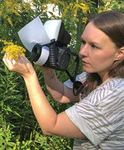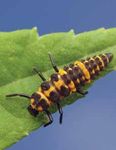Getting Started with Insect Identification
←
→
Page content transcription
If your browser does not render page correctly, please read the page content below
C
insect insights
Getting Started with Insect Identification
by Danae Wolfe
I
HAVEN’T ALWAYS appreciated the class Insecta—known as insects—are clas- scientific names can help gardeners and
importance of insect identification. sified as having three main body segments: scientists alike communicate unambigu-
When I began photographing in- the head, the thorax, and the abdomen. All ously about a species.
sects over 10 years ago, I routinely shared insects have three pairs of legs. Most insects
my photos on social media with nary a also have one pair of antennae and one pair INSECT LIFE CYCLES
species name in sight. I spent more time of compound eyes, though there are excep- We can also group insects by shared life
editing (and oversaturating) my photos tions in some species. Most adult insects cycle characteristics. In insects, there
than I did learning about and identifying are winged, but some species are wingless. are two prominent types of life cycles—
the animals I photographed. Insecta can be further classified into hemimetabolous and holometabolous.
Thankfully, as my entomological en- orders and within each order, divided Hemimetabolous insects, like grass-
thusiasm has grown over the years, so
too has my interest in insect identifica-
tion. Today, I understand that properly
identifying insects can equip gardeners
with the knowledge to make informed
landscape decisions. Landscape manage-
ment, after all, should not begin with an
automatic assumption that all bugs are
bad. In fact, most insects (and spiders)
are incredibly beneficial for the garden.
So how do we know which insects are
good, which might need a bit of man-
agement to control, and which should
be reported to the local Extension office
or Department of Agriculture? The first
step is identification.
Properly identifying the insects we
meet in our gardens can help ensure we
aren’t unnecessarily using harmful chem-
icals, help prevent the spread of invasive
species before they cause significant eco- All insects have three pairs of legs and three-part segmented bodies: the head, thorax, and
logical or economic damage, and alert abdomen. Most, like this lace bug, have two antennae and two compound eyes.
us to when we might need to take extra
protective measures to preserve a threat- into family, genus, and finally species. hoppers, treehoppers, dragonflies, and
ened species. In this article, I’ll share some Species is the finest unit of classification damselflies, are those that undergo in-
of the basics of insect taxonomy and re- we use to categorize an organism. complete metamorphosis. These insects
sources to help get you started with grow- This classification of organisms is have three life stages—egg, nymph, and
ing your identification skills. called taxonomy. Scientists use taxono- adult. Throughout the nymph stage,
my to classify groups of organisms based hemimetabolous insects resemble adults
WHAT MAKES AN INSECT AN INSECT? on shared characteristics. In addition to but lack developed wings and functional
With over one million described species of showing where species fall within the reproductive organs. Nymphs develop
insects in the world, learning to identify our world’s evolutionary family tree, taxon- through several growth stages called in-
six-legged friends can seem daunting. So, omy also helps ensure every identified stars, in which the insect grows and sheds
let’s begin broadly. Insects are classified in species has a scientific name and descrip- its exoskeleton through a process called
DANAE WOLFE
the kingdom Animalia, phylum Arthopo- tion. As with plants, common names molting. Molting happens several times
da, and class Insecta. All organisms in the of insects vary greatly across regions so before the insect emerges as an adult.
48 the American GardenerPlanting the Piet Oudolf Way
Taught by Piet Oudolf &
Noel Kingsbury
True bugs, like these keeled treehoppers (Entylia carinata), are hemimetabolous and undergo
incomplete metamorphosis. Here, we see a nymph (far right), a newly emerged adult (center)
whose wings are still unfurling after molt, and a mature adult (left).
Holometabolous insects, like but- Some of the orders of hemimetabolous Upgrade your
terflies, beetles, flies, and bees, undergo insects you’re likely to find in your gar-
complete metamorphosis. These insects den include: gardening skills
have four life stages—egg, larva, pupa, Hemiptera: True bugs, cicadas, aphids
and adult. Larval forms of holometab- (82,000 species identified) Choose from over 30 online
olous insects vary greatly from their Orthoptera: Grasshoppers, crickets, ka- courses and learn under the
adult forms, spending their time eating tydids (20,500 species) watchful eye of some of the
and preparing for pupation. During Odonata: Dragonflies and damselflies world's biggest names in
the non-feeding pupal stage, the insect (5,500 species) gardening.
transforms into an adult. Mantodea: Mantids (1,800 species)
Dermaptera: Earwigs (1,800) Taught in our friendly online
classroom, where you get to enjoy
inspirational lessons and easy to
Some of the orders of holometabolous
follow assignments you will learn
insects you’re likely to find in your gar- the full range of skills needed to
den include: become the complete gardener.
Coleoptera: Beetles (400,000 species)
Lepidoptera: Butterflies and moths Learning with Experts is the only
(150,000 species) online course provider to offer you
Hymenoptera: Bees, wasps, parasitoids, personalised feedback from the
ants (130,000 species) very best experts all from the
Diptera: Flies, midges, mosquitoes comfort of your own home.
(120,000 species)
Neuroptera: lacewings, owlflies, mantid- Buy today and start anytime:
flies, (5,000) learningwithexperts.com
Keep in mind that taxonomy is
an ever-evolving science. As more
insects are discovered and described,
our understanding of how species are It is amazing to be able to
Lady beetles (family Coccinellidae) are related and where they belong in the learn and receive feedback
holometabolous and undergo complete evolutionary tree is refined. As such, directly from the experts.
DANAE WOLFE (2)
metamorphosis. Lady beetle larvae, like this educational resources that are even just
one, are beneficial predatory insects that a few years old might offer differing - Julia
feed on other small insects in the garden. information.
March / April 2021 49DEEPER DIVE who can help with identification. These
If you’re feeling unsure about your insect tools, powered by citizen scientists,
identification skills, there are lots of great contribute to ever-growing data sets
resources to help you grow your knowledge that can help scientists track changes
and confidence. Because I’m a photogra- in wildlife populations. These data sets
pher, my favorite books are those loaded are invaluable to helping us understand
with color photos and easy-to-digest descrip- which insect species might need our help.
tions. I’m partial to the National Wild- Next time you visit your garden, consider
life Federation Field Guide to Insects snapping a few photos of the insects you
and Spiders of North America (2007) meet and uploading your pictures to
by Arthur V. Evans, and Garden Insects iNaturalist or BugGuide. It could be you
of North America: The Ultimate Guide who discovers the next new species!
to Backyard Bugs, 2nd edition (2018) by In the next few articles, we’ll take
Whitney Cranshaw and David Shetlar. an even deeper dive into specific insect
More localized field guides are great orders where I’ll highlight identifying
for narrowing the focus down to species characteristics, species you’re likely to
that are likely to appear in your region find in your garden, and what you can
(though our changing climate is push- The author uses a variety of resources to help do to help protect and preserve our lit-
ing species outside historical ranges). I her identify the insects she photographs. tlest neighbors. m
own a number of Ohio-specific insect
and spider field guides that are small I also recommend getting acquainted Danae Wolfe is a macro photographer and
enough to toss in my purse or camera with online entomology and naturalist conservation educator based in Wooster,
bag for quick reference. I encourage you communities like iNaturalist and Ohio. She manages Chasing Bugs (www.
to check with your state’s Department BugGuide. These platforms allow you chasingbugs.com), a platform that
of Natural Resources to see what field to share observations and photos of promotes the appreciation, stewardship,
guides they might offer. insects with online community members and conservation of insects and spiders.
NE
W
!
ALYSSUM (AURINIA) saxatile ’Gold Kobold’
Exciting New Perennial
Varieties from Seed
www.jelitto.com
SO CAN YOU.
COURTESY OF SCOTT WOLFE
Production · Breeding · Seed Technology
USA Office: 125 Chenoweth Ln. · Louisville, KY 40207
Phone (502) 895-08 07 · Fax (502) 895-39 34 · maryv@jelitto.com
German Headquarters: P. O. Box 1264 · D-29685 Schwarmstedt
Fax 01149-50 71-98 29-27 · www.jelitto.com · info@jelitto.com
50 the American GardenerYou can also read

























































